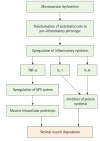Beyond survival: understanding post-intensive care syndrome
- PMID: 38863353
- PMCID: PMC11167423
- DOI: 10.4266/acc.2023.01158
Beyond survival: understanding post-intensive care syndrome
Abstract
Post-intensive care syndrome (PICS) refers to persistent or new onset physical, mental, and neurocognitive complications that can occur following a stay in the intensive care unit. PICS encompasses muscle weakness; neuropathy; cognitive deficits including memory, executive, and attention impairments; post-traumatic stress disorder; and other mood disorders. PICS can last long after hospital admission and can cause significant physical, emotional, and financial stress for patients and their families. Several modifiable risk factors, such as duration of sepsis, delirium, and mechanical ventilation, are associated with PICS. However, due to limited awareness about PICS, these factors are often overlooked. The objective of this paper is to highlight the pathophysiology, clinical features, diagnostic methods, and available preventive and treatment options for PICS.
Keywords: ABCDEF bundle; COVID-19; cognitive impairment; impaired muscle regeneration; intensive care unit; postintensive care syndrome.
Conflict of interest statement
No potential conflict of interest relevant to this article was reported.
Figures



Similar articles
-
Effects of evidence-based ICU care on long-term outcomes of patients with sepsis or septic shock (ILOSS): protocol for a multicentre prospective observational cohort study in Japan.BMJ Open. 2022 Mar 28;12(3):e054478. doi: 10.1136/bmjopen-2021-054478. BMJ Open. 2022. PMID: 35351710 Free PMC article.
-
Post-intensive care syndrome: its pathophysiology, prevention, and future directions.Acute Med Surg. 2019 Apr 25;6(3):233-246. doi: 10.1002/ams2.415. eCollection 2019 Jul. Acute Med Surg. 2019. PMID: 31304024 Free PMC article. Review.
-
"The Psychiatric Domain of Post-Intensive Care Syndrome: A Review for the Intensivist".J Intensive Care Med. 2024 Aug 22:8850666241275582. doi: 10.1177/08850666241275582. Online ahead of print. J Intensive Care Med. 2024. PMID: 39169853 Review.
-
Post-intensive Care Syndrome.Ann Geriatr Med Res. 2021 Jun;25(2):72-78. doi: 10.4235/agmr.21.0048. Epub 2021 Jun 25. Ann Geriatr Med Res. 2021. PMID: 34120434 Free PMC article.
-
Post-Intensive Care Syndrome and Its New Challenges in Coronavirus Disease 2019 (COVID-19) Pandemic: A Review of Recent Advances and Perspectives.J Clin Med. 2021 Aug 28;10(17):3870. doi: 10.3390/jcm10173870. J Clin Med. 2021. PMID: 34501316 Free PMC article. Review.
Cited by
-
Supporting Post-ICU Recovery: A Narrative Review for General Practitioners.Diseases. 2025 Jun 11;13(6):183. doi: 10.3390/diseases13060183. Diseases. 2025. PMID: 40558594 Free PMC article. Review.
-
Prevalence of Post-intensive care syndrome among intensive care unit-survivors and its association with intensive care unit length of stay: Systematic review and meta-analysis.PLoS One. 2025 May 8;20(5):e0323311. doi: 10.1371/journal.pone.0323311. eCollection 2025. PLoS One. 2025. PMID: 40338918 Free PMC article.
-
Acute stress disorder in patients with traumatic spinal cord injury: risk factors and coping strategies.Front Psychiatry. 2025 May 19;16:1555589. doi: 10.3389/fpsyt.2025.1555589. eCollection 2025. Front Psychiatry. 2025. PMID: 40458784 Free PMC article.
References
-
- Smith S, Rahman O. StatPearls Publishing; 2023. Postintensive care syndrome [Internet] [cited 2023 Dec 1]. Available from: https://pubmed.ncbi.nlm.nih.gov/32644390/ - PubMed
LinkOut - more resources
Full Text Sources

